Shipyard named after 61 communard. The squadron battleship "Prince Potemkin-Tavrichesky" (part 2)
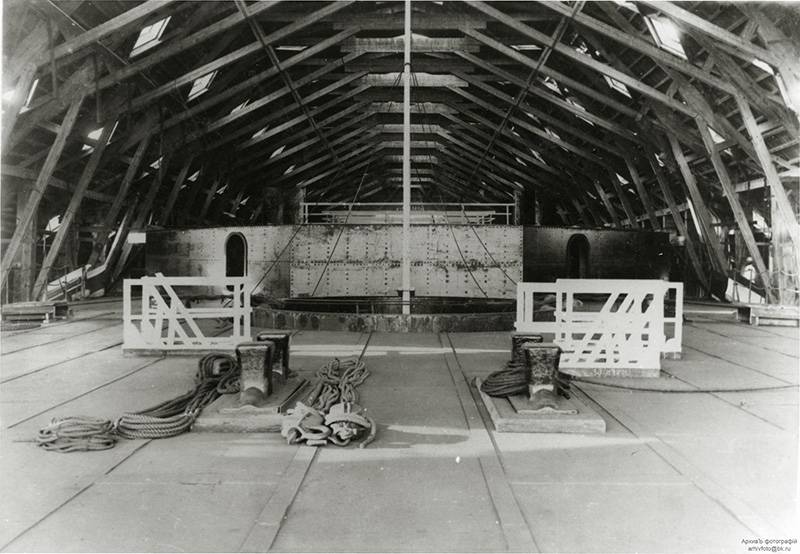
Petersburg demanded fulfillment of the terms, which were constantly shifted. The shipyard burst out trying to break out of the bureaucratic chains and overcome administrative obstacles. The industry promised and let down. The descent of the battleship was postponed. No one else in the Russian Empire knew that very soon the battleship Potemkin would thunder to the whole country, and then to the whole world.
The descent of the battleship "Potemkin"
The Izhora plant, a supplier of corps steel, suddenly found itself overwhelmed with similar orders for ships being built in the Baltic. Its production capacity in the calculations turned out to be exaggerated, and in July 1898, the order for further production had to be transferred to the Alexander Steel Plant in St. Petersburg. This company has requested much more expensive, but the leadership of the construction of the battleship did not have any special alternatives. Of course, attempts were made previously to find a manufacturer of the metal with a total mass of 3600 tons closer, in the southern Russian provinces. But none of the nearby metal manufacturers decided to undertake such work.
"Prince Potemkin-Tavrichesky" was the first domestic ship on which the traditional to this time Harvey armor steel was replaced with a new, Krupp one. According to the signed contract between the Krupp concern and the Izhora plant, the German representatives had to not only transfer the technology of its manufacture, but also advise on the production process. In an effort to quickly complete the contract, Krupp engineers rushed to assure the Russian side that the Izhora plant was fully prepared and capable of producing slabs according to the German model. In fact, everything was not so rosy - the introduction of another technology was painfully difficult. Izhora plant had to simultaneously upgrade production, conduct various experiments and make the most armor. All this could not affect the timing of its release.
Under the terms of the contract, the steel for the Potemkin was to be delivered from St. Petersburg in batches of 815 tons. At the beginning of April, 1899, the first, made a batch of armor with a mass of 90 tons, manufactured by the Izhora plant. During the summer, 315 tons were delivered by steamboats around Europe.
In late autumn, another lot arrived in 55 tons on the steamer “Ceres”. Her way to the shipyard was full of various adventures. Ceres arrived in Odessa to complete the navigation, and the barge, which was overloaded with armor plates, could not climb up the Southern Bug. ROPiT postal steamers were still walking along the river, but for some reason no one thought to use them to complete the transport operation.
The builder was forced to raise the issue of cargo delivery to the shipyard with all seriousness, since the absence of armor plates would slow down the pace of construction. The management of ROPiT nevertheless promised to overload the plates on postal steamers, but in the end fell into forgetfulness and the promise did not fulfill. Consideration of emergency options began, such as the delivery of armor by shuttle flights of the small port icebreaker "Gaydamak".
While there were numerous bureaucratic approvals, the Southern Bug, tired of waiting, finally froze, and the problem reached a new level. In early January, 1900, when its decision reached the General Directorate of Shipbuilding and Supplies, Petersburg gave the go-ahead for the delivery of armor by rail. First, frozen, like Nansen's "Fram", the barge was freed from the captivity in the ice, then, having moved to a suitable place, they began unloading. This was followed by a time-consuming procedure for moving cargo into railway wagons.
For the whole operation, despite the shouting from Nikolaev, it took more than a month, and the cars loaded with armor plates traveled from Odessa to Nikolaev for a week. The rest of the Potemkin armor was delivered to the shipyard only by the fall of 1900. In Nikolaev, the arriving plates had to be dug and refined along the edges, using for this purpose the only rollers in an insufficiently equipped local armored workshop.
The launch of the Prince Potyomkin-Tavrichesky scheduled for the spring of 1900 has been postponed. In addition to armor problems, there was a delay in the delivery of stern shafts from Germany, and from St. Petersburg - propellers produced by the Izhora plant. On the battleship so far there was no bow. All these missing constructions arrived at the shipyard only in the second half of the summer instead of the initial spring terms. Then began the preparatory activities for the descent of the ship.
Elling No.7 of the Nikolaev Admiralty, where the battleships had previously been built, did not have a bat-port. To inspect and prepare underwater runners, it was necessary to erect a temporary jumper at the ends of the dams that fenced the underwater part of the stocks and pump out the water from there. This procedure was time consuming and required great effort. It was necessary to drive two rows of wooden piles, the total number of 300 pieces, and fill the space between them with mint clay of about 700 cubic meters. The jumper construction began in November 1899, and now, nine months later, was nearing completion.
By the end of September, the bulk of the work on the ship's hull was completed, and it was considered quite ready for launching. The total weight of the battleship "Prince Potyomkin-Tavrichesky" on the stocks reached 3720 tons by this time, of which 540 tons of deck armor. In the admiralty and in Nikolaev itself, preparatory activities began to launch the ship: the printing houses ordered 1000 release cards with the image of a battleship and 2000 release tickets, of which 600 were in color.
The distinguished guests were expected - Emperor Nicholas II and his family were at that time in Livadia. An intensive exchange of radiograms began between Nikolayev, Sevastopol and the royal yacht "Standart". The Nikolaev society of pilots undertook to carry out the yacht having a draft of 6,4 meter along the fairway to Nikolaev, while guaranteeing the unhindered passage of small silted bottom areas. However, the commander of the "Standard" chose not to risk, and the launch of the "Prince Potyomkin-Tavrichesky" took place without the august couple.
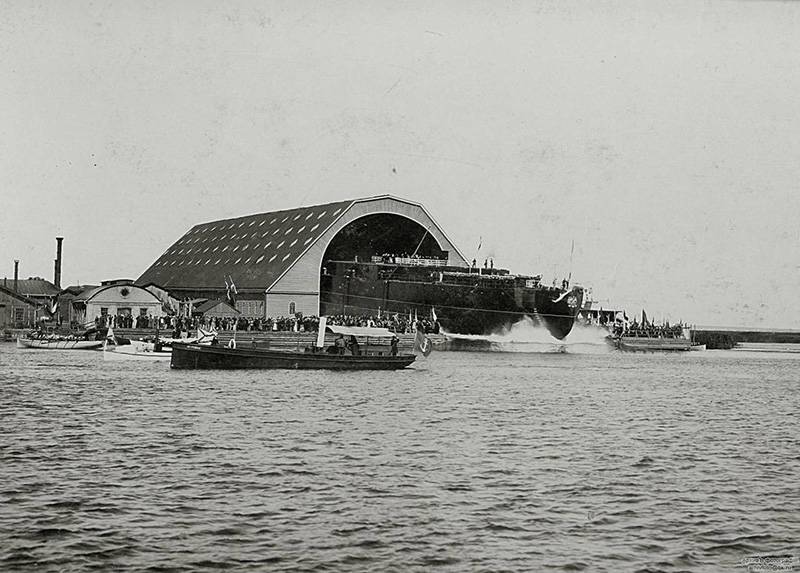
On September 25, 1900, the chief commander of the Black Sea arrived from Sevastopol on the heading ship "Erick" fleet Vice Admiral Tyrtov. The ceremony itself was scheduled for September 26th. In the morning, 200 soldiers arrived at the shipyard, stationed in Nikolaev, of the 58th Prague Regiment, who, along with the crew of the battleship, were involved to assist in the descent procedure. The chief builder of the ship, engineer Schott, commanded the descent.
After the ceremonial prayer service, Prince Potemkin-Tavrichesky, freed from the arrestors, followed by a six-time “Hurray”, safely descended into the water. Solemn telegrams were sent to Livadia and Petersburg, informing about safe descent. A new phase of construction has begun - the completion of the ship afloat.
After descent
The relatively small height of the slipway No. XXUMX and the absence of mechanized crane means in it made it possible, by the time of descent, to complete the building only to the battery deck. Now the shipyard workers had already afloat to assemble the design of the forecastle with the upper armored casemate, spardek, superstructures, bridges, etc. It was necessary to mount almost all the vertical armor, load and install a large number of various mechanisms and equipment. For all this considerable amount of work, only a year and a half was allocated - it was assumed that in the spring of 7, the ship would go to Sevastopol for final completion.
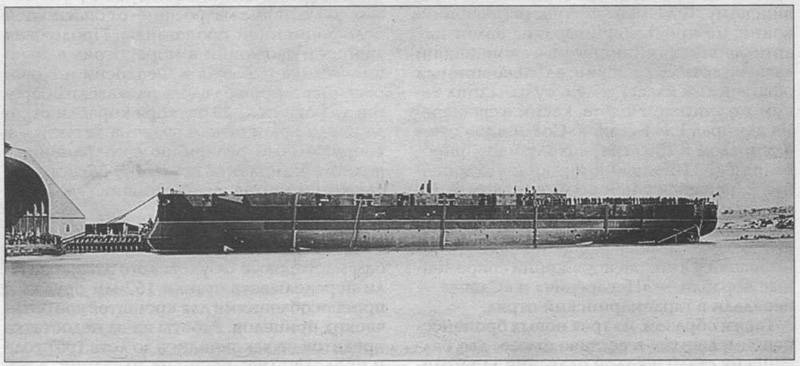
As it turned out later, these dates were too optimistic. The completion of the Potemkin was delayed for almost two years, and he left the main base of the fleet with numerous deficiencies. As before, exhausted from modernization, the Izhora plant delayed the supply of armor - its products were more than a year late for the upper casemate and traverses. Slabs began to flow to the shipyard only in March 1901 of the year.
Seeing that the Izhora could not cope with the load, it was decided to seek the help of foreigners. Within the framework of a large (1870 tons) order of armor for the Russian fleet, the British factory Birdmore and Co. was to produce 257 tons of its products for Potemkin. The British in terms of the execution of the order were quite at the level of domestic producers. Engineers from the Birdmore company, who were supposed to come to the shipyard in Nikolaev and accept the wooden templates of armor and drawings, had to wait more than two months.
The templates themselves, which, out of economy, contrary to the experience, were made of wood, and not of steel, began to shrink and required rework. Changes needed drawings. Waiting for shiploading, the port authorities overlooked the port authorities for a long time under the open sky - for some reason they felt sorry for the tarpaulin. Finally, the long-suffering patterns loaded onto the German commercial steamer, going alternately to the ports of Bulgaria, Greece, Turkey and Holland, arrived in England only in October 1901.
The path of the main steam engines to installing them on the battleship was no less thorny, mainly because of bureaucratic shoals and judicial reefs. At the end of 1900, the new Nikolaev shipbuilding plant "Naval" completed the assembly of the mechanical heart "Potemkin" and made tests on its own stand. However, the installation of steam engines on the battleship was delayed for many months. The problem was that between the board of the Belgian joint-stock company and the General Directorate of Shipbuilding and Supplies for the second year there were trials.
The board, waving the text of the contract, demanded to transfer “Prince Potyomkin-Tavrichesky” to the extension wall of the Naval plant. In the Main Directorate, they understood that such a procedure could further delay the already tortoise pace of the construction of the battleship, so they maneuvered as best they could. The matter was finally settled by the payment by the customer of solid compensation to the great joy of the board of the Belgian joint-stock company, and Potemkin remained to be completed in the Admiralty water area.
Installation of boilers and machines was completed by the end of 1901. The mooring tests carried out by 1 of December showed good quality of Naval products: the machines worked properly, without effort bringing the propeller rotation to 40 revolutions per minute.
The difficult situation was with the towers of the main caliber, which also worked "Naval". In March, 1902, when they began to demand that the battleship be expelled from the factory from Sevastopol, it turned out that the manufacturer could not begin assembling the towers until mid-June. In this regard, the chief builder, engineer Schott, insisted on the need to postpone the departure of the battleship to Sevastopol. But the command of the fleet would rather overtake the Potemkin to Sevastopol.
In the end, Schott's arguments were rejected, and it was decided to transfer the unfinished ship in June, although according to the initial plans, this operation was scheduled for the beginning of the spring 1902 of the year with the towers already mounted. Began assault preparation for the transition to the main base. Along with numerous outbuilding works - the installation of armor and equipment - various materials were loaded onto the Potemkin to continue the completion already in Sevastopol. To assist the workers of the Admiralty were allocated personnel from the "Naval".
Completion and service
8 June 1902 of the Year "Prince Potemkin-Tavrichesky" raised a naval flag and joined his first campaign. 20 June, accompanied by the training ship "Dniester" and several port ships, an unfinished battleship finally left the Nikolaev Admiralty. On board, in addition to the crew, there was a greater number of artisans and employees of both Nikolaev shipbuilding plants. June 21 in the afternoon, the ships arrived in Sevastopol, where the new battleship stood on a barrel.
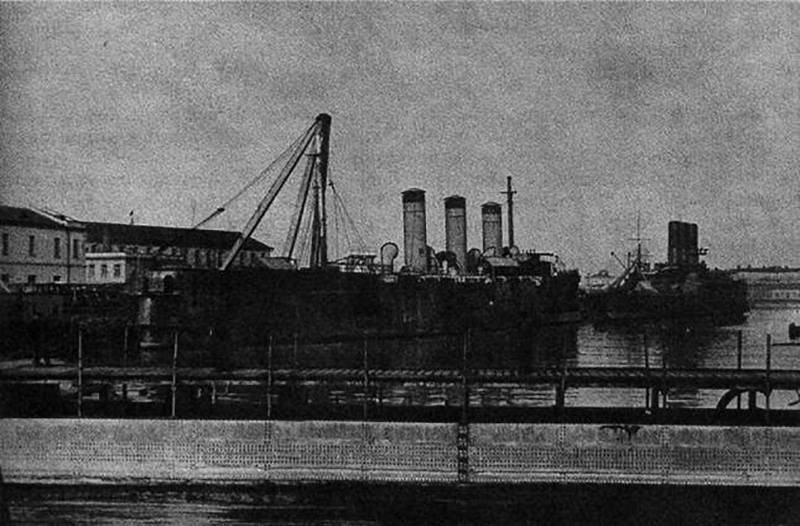
25 June "Potemkin" moved to the South Bay and stood for a long time at the extension wall of the Lazarevskiy Admiralty to continue the work. Initially, they used equipment and materials arrived at the Potemkin from Nikolaev. However, these reserves were soon exhausted, and for the delivery of new components, the command had to organize regular flights of naval transports to Nikolaev.
In mid-November, the chief builder of the Potemkin, an engineer, Shott, was assigned to the battleship under construction, Evstafy, and his place was taken by Vladimir Vladimirovich Konstantinov, the junior shipbuilder of the Sevastopol port. By the spring of 1903, in general, the installation of the main belt armor plates was completed and the assembly of the conning tower began.
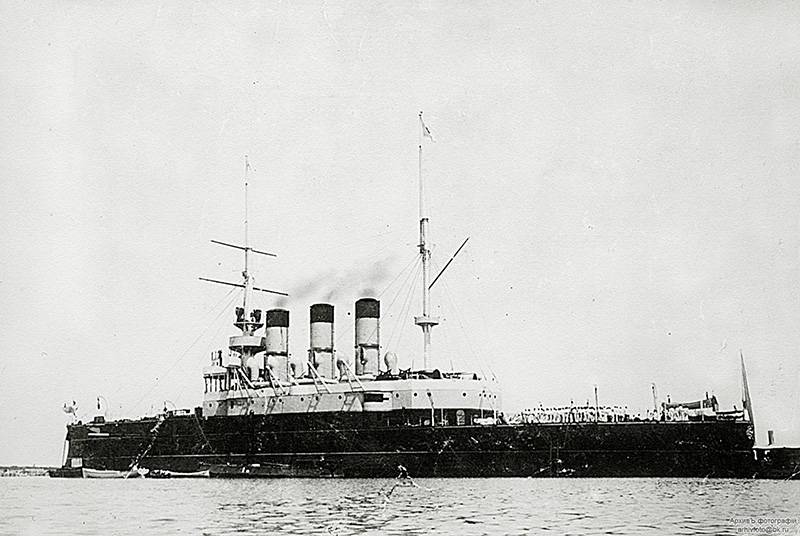
The epic with the towers of the main caliber did not stop. The Naval Technical Committee demanded that Naval deliver all the machines with 305-mm guns to the naval artillery range near St. Petersburg for test shooting and then mount them on a battleship. In the summer of 1903, all guns with machine tools were finally sent from Nikolaev to the test site. The prospect of getting "Potemkin" its main caliber smoothly moved over to 1904 year.
15 October 1903, the ship made a trial out to sea, and in November, it was running trials. The special commission recognized the work of the machines as a whole to be satisfactory. On the morning of December 20, in the fore oil stoker (part of the battleship's boilers had liquid fuel supply) a fire occurred - the oil caught fire. A few hours later, the fire was localized, but part of the premises and structures received significant damage. Because of this incident, the commission investigating this case, strongly advised to further abandon the oil boilers not only on the Potemkin, but also on the battleships Evstafy and John Chrysostom under construction.
The year “Prince Potemkin-Tavrichesky” met the coming 1904 with continuing construction works and without artillery of the main caliber. The ship was in construction for the seventh year. The Russo-Japanese war began, and the Navy Department demanded that the battleship be commissioned no later than 1 in January 1905.
The aft tower of the main caliber was still in Nikolaev, and only in September 1904 of the year did the commission of the Marine Technical Committee recognize it operational. A little earlier, a similar procedure was carried out with the nose tower, and in December 1904, both of them were installed on the ship. In the tower finally installed 305-mm guns and covered with armored covers.
The workers of the Nawal plant completed their activities in the spring of 1905 of the year, and 28 of March of 1905 of the year received a report on their readiness to be tested by shooting. It was not possible to bring the Potemkin to a combat-ready state by January 1 1905. During April-May, the battleship underwent various tests at sea, including artillery firing. In May 1905, the ship finally entered the Black Sea Fleet after nearly nine years of construction.
The Potemkin service began violently: 14 June 1905, when the battleship was in the area of the Tendrovsky Spit, a rebellion broke out on it. Some officers were killed, the rest were arrested. The boarding team from the Potemkin captured the old destroyer, No. XXUMX, which was in the capacity of a messenger for the battleship. The official reason for the uprising for a long time was considered to be stale provisions purchased in Odessa. According to a later version, the performance of the Potemkin crew was part of the plan of a general uprising in the Black Sea Fleet, and in this case a false start occurred.
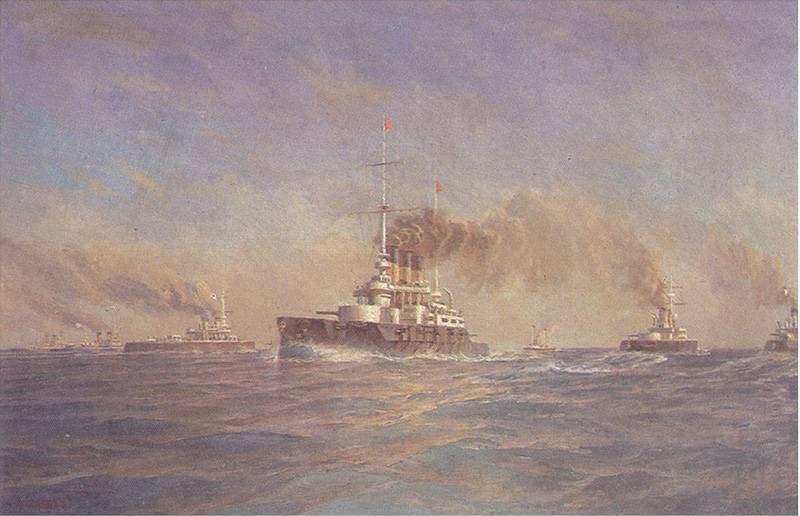
10 days both ships with red flags plied the Black Sea, the meeting with the government squadron of Admiral Krieger ended with the transfer to the side of the rebels battleship George the Victorious, which, however, after a day again came under the control of the government.
The news of the uprising on the "Potemkin" shook the whole country, not having had time to move away from the recent merciless Tsushima defeat. Having exhausted the reserves of coal and provisions, not having a clear plan of action, the battleship Potemkin went to the Romanian port of Constanza, where his team went ashore.
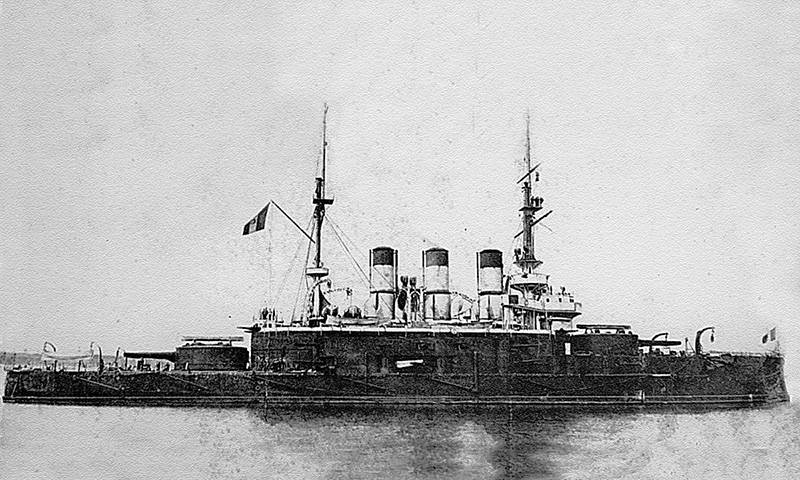
Soon the rebellious ship in tow of the battleship Sinop returned to Sevastopol. In October 1905 of the year it was renamed Panteleimon, and in November of the same year the disarmed battleship took part in the Sevastopol uprising led by Lieutenant Schmidt.
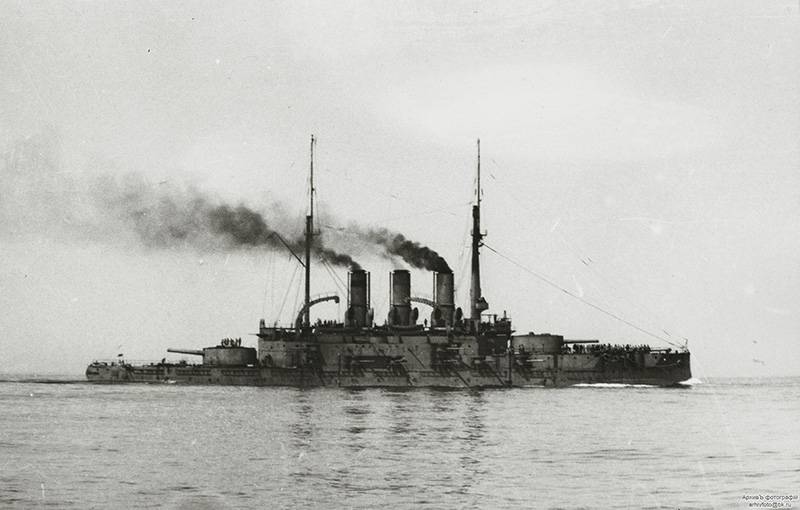
Reclassified in the battleship in 1907, the Panteleimon took an active part in the First World War, including the famous battle at Cape Sarych in November 1914.
After the February Revolution, 1917 was renamed Potemkin-Tavrichesky, and from 11 in May 1917, it became Freedom Fighter. In the 1919 year, the old invaders in Sevastopol foreign interventionists disabled the machine. Restoration of the ship was considered inappropriate, and in the first half of the 1920-ies. he was gradually dismantled for scrap.
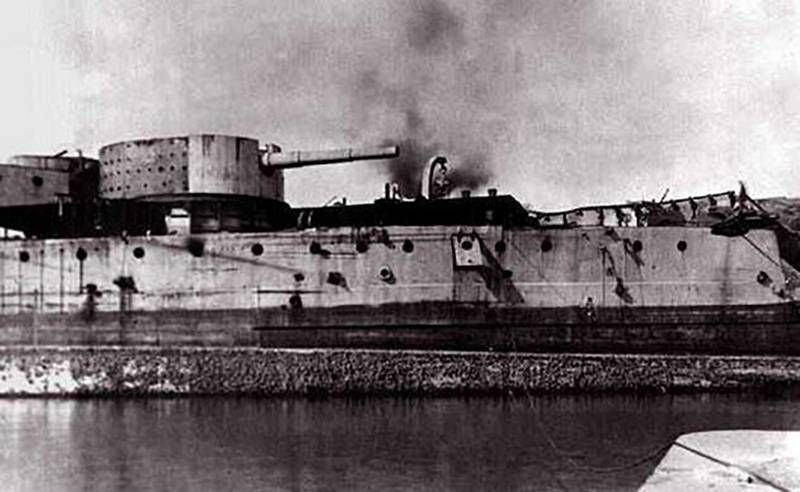
During the filming of the famous film by Sergey Eisenstein “The Battleship Potemkin”, the role of the rebel ship was played by an older but better-preserved battleship "Twelve Apostles". From the very same "Potemkin" by this time there were only parts of the foremast, stored in several museums, including the Museum of the Black Sea Fleet in Sevastopol.
To be continued ...
Information